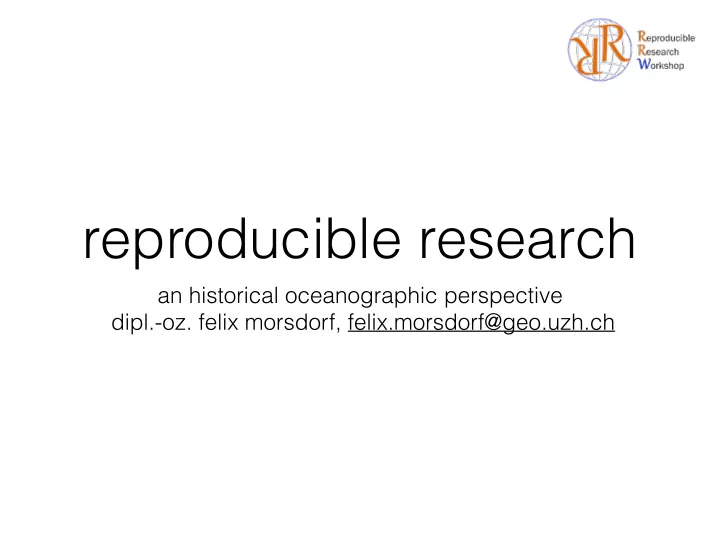

reproducible research an historical oceanographic perspective dipl.-oz. felix morsdorf, felix.morsdorf@geo.uzh.ch
reproducibility is not “nice to have” “Reproducibility is one of the main principles of the scientific method.”
sea-surface salinity simulation
ctd probe conductivity, temperature and depth • physical or experimental oceanographers probe the ocean using ctds • ships are used to navigate along transects • every 10-30 nm a probe is lowered
world ocean circulation experiment (woce) transects different nations, different scientists,different ships, different instruments, different calibration schemes
student’s question • how can single ship-based measurements in such a complex spatio-temporal system be reproducible? • e.g. how do we know if a measurement is right or wrong? • supervisor: “it will come out eventually…”
Study of a Karman vortex using the FFD solver – “Design Systems, Ecology and Time” – ACADIA 2012 physical models
inverting hydrographic box models • horizontal layers to incorporate the stratification • stationary subsets of governing equations, constrain the model with data (and priors…) • find one (of the many…) inverse solutions http://www.seos-project.eu/modules/ oceancurrents/oceancurrents-c06-s02- p01.html
CLIVAR Conference, Kiel, 2000 • A. Ganachaud (PhD of inverse modelling “guru” Carl Wunsch) showed his inversion results using the WOCE transects Global circulation summary 15 ± 2 standard solution (Sv) 50 ° N γ n <27.72 27.72< γ n <28.11 3 ± 1 14 ± 2 28.11< γ n 16 ± 2 12 ± 2 1.5 ± 1 1 ± 3 25 ° N 0.5 ± 4 4 ± 2 2.5 ± 4 5.5 ± 2 13 ± 2 (Entire Atlantic) 0 ° 19 ± 5 7 ± 2 11 ± 5 10 ± 2.5 16 ± 5 16 ± 3 6 ± 1.3 3 ± 5 25 ° S 8 ± 4 9 ± 3 14 ± 6 23 ± 3 27 ± 6 50 ° S (Entire Southern) 157 ± 10 140 ± 6 21 ± 6 8 ± 9 60 ° W 0 ° W 60 ° W 120 ° W 180 ° W 120 ° W Ganachaud, A. and Wunsch, C. (2000). Improved estimates of global ocean circulation, heat transport and mixing from hydrographic data. Nature, 408(6811):453–457.
Ganachaud, A. and Wunsch, C. (2000). Improved estimates of global ocean circulation, heat transport and mixing from hydrographic data. Nature, 408(6811):453–457.
WOCE Argo T/P, Jason GRACE How to synthesize? Estimation/optimal control problem: Use a model (MITgcm) and its adjoint : slide from C. Wunsch, NCAR, 2008
Conclusions (i) • Data needs to fit abstracted view (e.g. models) of the world system • If data does not fit - • i) model is wrong or we are outside model domain • ii) data might have “problems”, i.e. measurement errors that hinder reproduction of results
Conclusions (ii) • Sampling is always an issue. • Model development helps to test “reproducibility” of field measurements. • State of the art for complex systems with well- defined principles: model based data assimilation. • Atmosphere (++), Oceans (+), Biosphere (-)
Recommend
More recommend